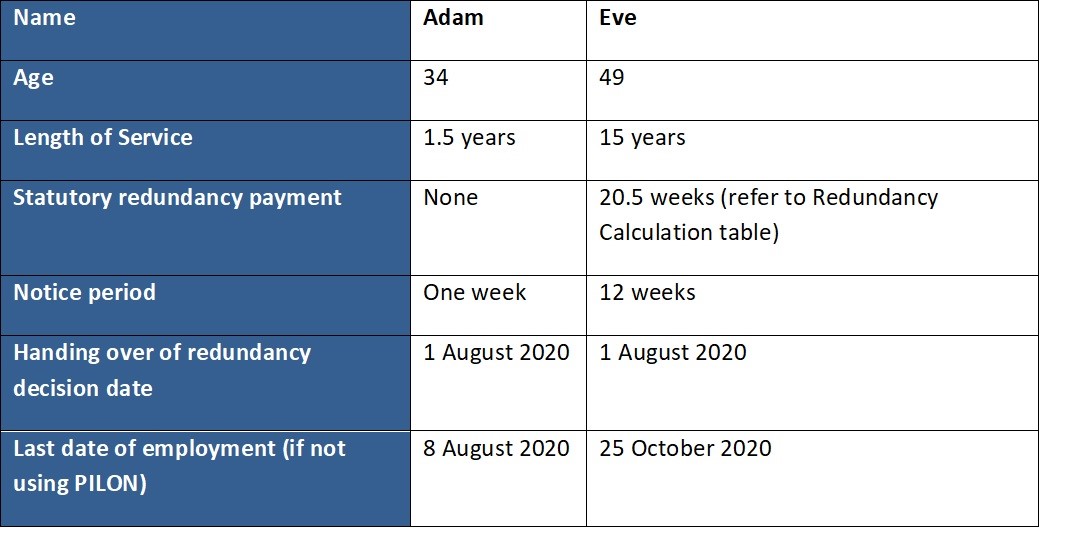Your Rights to Redundancy If Company Goes Bust: UK Employee Protections
Your Rights to Redundancy If Company Goes Bust: UK Employee Protections
Blog Article
Exploring the Interplay In Between Company Redundancy and Organizational Flexibility for Future Development
In the vibrant landscape of today's service world, the elaborate partnership between company redundancy and business adaptability emerges as a crucial variable for sustained development and success. Business often face the challenge of striking a fragile equilibrium between keeping a level of redundancy to mitigate risks and fostering flexibility to react promptly to the ever-evolving market needs.
Importance of Company Redundancy
Firm redundancy is an essential element that boosts organizational strength and reduces functional dangers. By integrating redundancy measures within the organizational framework, business can much better hold up against unexpected interruptions and variations in the service environment. Redundancy works as a strategic barrier, permitting firms to adjust and react efficiently to unforeseen obstacles without compromising necessary operations.
One trick facet of the value of company redundancy is its function in making certain connection during times of crisis. When confronted with sudden modifications or emergency situations, redundant systems, resources, or workers can tip in to maintain critical functions and avoid extensive interruptions. This continuity not only safeguards the business's reputation and customer depend on yet likewise reduces monetary losses and operational downtime.

Strategies for Organizational Adaptability

Another critical approach is buying technology and facilities that can sustain flexibility and scalability. Carrying out electronic devices, automation, and data analytics can improve operations, improve performance, and provide useful insights for educated decision-making. Additionally, producing adaptable business frameworks that permit quick changes to market dynamics and customer demands is vital for staying competitive in a rapidly progressing environment. By proactively recognizing potential interruptions and possibilities, organizations can proactively adapt and grow in an ever-changing business landscape.
Balancing Redundancy and Flexibility
Accomplishing an unified equilibrium between functional redundancy and business adaptability is extremely important in navigating the complexities of a vibrant business environment. Striking the appropriate balance in between redundancy and versatility is a fragile procedure that calls for a deep understanding of the company's objectives, sector characteristics, and risk resistance.
To accomplish this balance, firms require to carry out normal analyses of their operations to determine locations where redundancy is essential for threat reduction and where adaptability can drive advancement and development. Carrying out basics versatile structures, fostering a society of continuous knowing and improvement, and encouraging open interaction across all degrees of the organization are key techniques to integrate redundancy and versatility efficiently. By aligning these two critical components, companies can place themselves for sustainable development and success in an ever-changing company landscape.
Case Researches on Adaptation Success
In checking out circumstances of successful business adaptation, it comes to be evident that the interaction in between functional redundancy and adaptability is a defining variable in shaping durable services. One go now compelling situation research study is that of Netflix. At first a DVD rental solution, Netflix demonstrated exceptional flexibility by transitioning into a streaming system when digitalization interfered with the sector. By tactically spending in modern technology and content production, Netflix not only grew however survived in a swiftly progressing market. An additional standout example is Amazon. Beginning as an online bookstore, Amazon continuously adjusted its service design, broadening into diverse markets such as cloud computer and expert system. This adaptability allowed Amazon to remain in advance of rivals and meet altering consumer needs. Lastly, Adobe gives a noteworthy illustration of effective adjustment. The company shifted from marketing software licenses to a subscription-based version, ensuring persisting earnings streams and enhanced client engagement. These study highlight the importance of functional redundancy paired with business flexibility in fostering long-term growth and competitiveness.
Structure Strength for Future Growth
Structure strength for future growth needs a strategic alignment of operational procedures with market dynamics and arising patterns. Business must adjust to transforming environments by promoting a society of adaptability, development, and constant renovation. Resilience entails not only bouncing back from setbacks but additionally proactively preparing for future challenges. One crucial facet of structure durability is spending in robust risk monitoring methods to mitigate possible disturbances. This that site includes circumstance planning, expanding supply chains, and establishing backup prepare for different backups (who pays redundancy money).
In addition, cultivating solid partnerships with stakeholders, such as customers, staff members, vendors, and the area, is necessary for weathering uncertainties and keeping trust fund and support throughout turbulent times. Effective communication and openness play an important role in building durability, as they aid straighten assumptions and help with collaboration in browsing uncertainties.
Moreover, companies require to prioritize understanding and advancement efforts to upskill staff members and furnish them with the needed devices to adapt to changing circumstances. By buying their labor force, firms can enhance their flexibility and agility, inevitably enhancing their resilience for lasting future development.
Conclusion

In the vibrant landscape of today's service globe, the elaborate partnership in between firm redundancy and organizational flexibility arises as a crucial element for sustained development and success. Business usually face the obstacle of striking a delicate equilibrium in between keeping a level of redundancy to minimize threats and cultivating flexibility to react swiftly to the ever-evolving market needs.To achieve this equilibrium, companies need to perform regular assessments of their operations to determine locations where redundancy is needed for danger reduction and where adaptability can drive technology and development.In final thought, the interplay between company redundancy and organizational flexibility is important for future development. Building durability through a mix of redundancy and adaptability will certainly make sure that firms are prepared for the challenges of the future.
Report this page